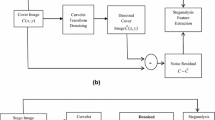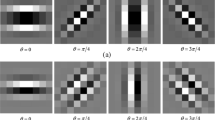Abstract
In steganalysis, there exist a good number of feature extraction techniques; the most commonly used feature extraction technique is based on the Discrete Wavelet Transform (DWT). Almost all of the techniques give a higher detection rate even for short messages, but they are limited to statistical moments such as Characteristic Function (CF) and Probability Density Function (PDF) moments to build their feature sets. A new feature extraction scheme in wavelet transform is presented in this paper. It is based on the adaptation of Zipf’s law to wavelet transform to extract new features obtained from the statistical distributions of wavelet pattern subbands that are represented by a graphical representation called a curve of Zipf. The originality of this work can be shown through two perspectives: the adaptation of Zipf’s law to wavelet subbands, which involves the determination of the pattern size used to count the frequency of pattern appearance, and an encoding model, which makes the distribution of pattern frequencies more significant. Moreover, this novel scheme proposes a new feature set extracted from the curve of Zipf of the wavelet subband coefficients, which is the first such attempt in DWT and the field of steganalysis. A Random Forest classifier (RF) is then used to model the resulting features. Experimental results show that the proposed steganalytic method has the best classification performance in terms of accuracy, which achieved 88.9, 78.25, 84.27 and 60.1%, compared with three feature sets based on CF moments and Markov features, histogram features, and co-occurrence matrix features, respectively.












Similar content being viewed by others
Explore related subjects
Discover the latest articles, news and stories from top researchers in related subjects.References
Anahita SH, Shahrokh G, Hamid SZ (2011) Universal steganalysis based on local prediction error in wavelet Domain. 7th international conference on intelligent information hiding and multimedia signal processing 165–168
Avcibas I, Kharrazib M, Memon N, Sankur B (2005) Image steganalysis with binary similarity measures. EURASIP JASP 17:2749–2757
Benguigui L, Blumenfeld LE (2007) Beyond the power law – a new approach to analyze city size distribution. Comput Environ Urban Syst 31(6):648–666
Bi A, Mraghni (1996) Spatial gray levels distribution based unsupervised texture segmentation. In: proceedings of 3rd international conference of signal processing (ICSP96), Pekin
Breiman L (2001) Random forest. Mach Learn 45(1):532
Burton GJ, Moorhead IR (1987) Color and spatial structure in natural scenes. J Appl Opt 26:157–170
Caron Y, Makris P, Vincent N (2007) Use of power law models in detecting region of interest. Pattern Recognit, Elsevier 40(9):2521–2529
Caron Y, Makris P, Vincent N (2002) A method for detecting artificial objects. In natural environments. RFAI team publication international conference on pattern recognition ICPR 2002, Quebec 600–603
Casti JL (1995) Bell curves and monkey languages. Complexity 1:12–15
Dekun Z, Yun QS, Wei S, Guorong X (2006) Steganalysis based on Markov model of threshold prediction-error image. In Proc. IEEE International Conference on Multimedia and Expo (ICME) 1365–1368
Dellandrea E, Makris P, Boiron M, Vincent N (2002) A medical acoustic signal analysis method based on Zipf law. RFAI publication: international conference on digital signal processing. SANTORINI (GRECE) 2:615–618
Egghe L (2005) The power of power laws and an interpretation of Lotkaian informetric systems as self-similar fractals. J Am Soc Inf Sci Technol 56(7):669–675
Farid H (2002) Detecting hidden messages using higher-order statistical models. In Proc. IEEE international conference image processing 2:905–908
Fengyong L, Xinpeng Z, Bin C, Guorui F (2013) JPEG steganalysis with high-dimensional features and Bayesian ensemble classifier. IEEE Signal Process Lett 20(3):233–236
Gireesh KT, Jithin R, Deepa DS (2010) Feature based steganalysis using wavelet decomposition and magnitude statistics. In Proc. international conference on advances in computer engineering (ACE) 298–300
Goljan M, Fridrich J, Holotyak T (2006) New blind steganalysis and its implications. In Proc. SPIE Security and Watermarking of Multimedia Content VIII 6072:1–13
Guoming C, Qiang C, Dong Z, Weighing Z (2012) Particle swarm optimization feature selection for image steganalysis. IEEE Computer Society, pp 304–308
Hamoud M, Merouani HF, Laimeche L (2014) The power laws: Zipf and inverse Zipf for automated segmentation and classification of masses within mammograms. Evolving systems. Springer, Berlin
Holotyak T, Fridrich J, Voloshynovskiy S (2005) Blind statistical steganalysis of additive steganography using wavelet higher order statistics In Proc. 9th IFIP Conference on Communication and Multimedia Security LNCS 3677:273–274
Jerome MS (1993) Embedded Image Coding Using Zerotrees Of Wavelet Coefficients. IEEE Trans Signal Process 41:12
Ker AD (2007) Steganalysis of embedding in two least-significant bits. IEEE Trans Inf Forensics Secur 02(01):46–54
Khalind SO, Aziz B (2013) Single-mismatch 2LSB embedding steganography. IEEE international symposium on signal processing and information technology (ISSPIT) 283–286
Kodovsky J (2012) JPEG-compatibility steganalysis using block-histogram of recompression artifacts. In: Proc. 14th information hiding conference Berkeley CA. Springer LNCS 7692:78–93
Kodovsky J, Fridrich J, Holub V (2012) Ensemble classifier for steganalysis of digital media. IEEE Trans Inf Forensics Secur 7(2):432–444
Laimeche L, Merouani HF (2012) A novel technique of steganalysis in uncompressed image through Zipf’s law. IJCIA 40(6):0975–8887
Lavalette D (1996) On a Zipf’s law extension to impact factors. INSERM U350 institut curie–Recherche, Bt 112, Centre Universitaire 91405, Orsay, France
Lei S, Zhimin G, Lin Wand Yun S (2006) An applicative study of Zipf’s law on web cache. Int J Inf Technol 12(24)
Liu QZ, Andrew HS, Chen ZX, Xu J (2008) Feature mining and pattern classification for steganalysis of LSBs matching steganography in grayscale images. Pattern Recognit 41(1):56–66
Lyu S, Farid H (2004) Steganalysis using color wavelet statistics and one-class vector support Machines. In: Proc. SPIE security, steganography and watermarking of multimedia contents 5306:35–45
Martinez M G, Martinez R A, Del-Rio M B, Mansilla R (2009) Universality of rank-ordering distributions in the arts and sciences. Journal pone 0004791, Mandalena, costa, Harvard University
Mun LK, Gerard L (2010) On the power law relationship of the critical transmitting range and the number of nodes of ad hoc networks. Int J Sensor Netw Indersceince 7(4):228–235
Petitcolas FAP, Anderson RJ, Kuhn MG (1999) Information hiding—a survey. In: Proc. IEEE special issue on protection of multimedia content, 87(7):1062–1078
Pevny T, Fridrich J (2007) Merging markov and DCT feature for multi-class JPEG steganalysis. In: proc. SPIE electronic imaging, security, steganography, and watermarking of multimedia contents IX 6505
Provos N (2001) Defending against statistical steganalysis. In: Proc. 10th USENIX Security Symposium 10: 323–336
Rencher AC (1995) Methods of multivariate analysis. Wiley, New York
Robin AK, Sujaya R, Sudhira HS (2012) An approach to regional planning in India. Int J Syst Syst Eng Indersceince 3(2):117–128
Sahoo G, Rajesh KT (2012) Secure image transmission using steganographic methodologies. Int J Multimedia Intell Secur Indersceince 1:169–190
Shaohui L, Lin M, Hongxun Y, Debin Z (2009) Universal steganalysis based on statistical models using reorganization of block based DCT coefficients. 5th international conference on information assurance and security 778–781
Sheikhan M, Moin MS, Pezhmanpour M (2010) Blind image steganalysis via joint co-occurrence matrix and statistical moments of contourlet transform. Intelligent Systems Design and Applications (ISDA) 10th International Conference 368–372
Shi YQ, Xuan GR, Zuo DK (2005) Steganalysis based on moments of characteristic functions using wavelet decomposition, prediction-error image and neural network. In: Proc. IEEE International Conference on Multimedia Expo (ICME) 269–272
Shuang HZ, Hong BZ (2007) Blind steganalysis using wavelet statistics and ANOVA. In: Proc. International conference of machine learning and cybernetics 5:2515–2519
Solanki K, Sarkar A, Manjunath BS (2007) YASS: Yet another Steganographic Scheme that resists blind steganalysis. In Proc. 9th information hiding workshop 16–31
Vincent N, Makris P, Brodier M (2000) Compressed image quality and Zipf’s law. In: International conference on signal processing (ICSP–IFIC-IAPR WCC2000), Beijing (China) 1077–1084
Wang Y, Moulin P (2007) Optimized feature extraction for learning-based image steganalysis. IEEE Trans Inf Forensics Secur 2(1):31–45
Westfeld A (2001) F5 a steganographic algorithm High capacity despite better steganalysis. Information hiding, in proceedings of the 4th international workshop, springer, Berlin, 289–302
Xiang Y, Zhang WH (2012) Effective steganalysis of YASS based on statistical moments of wavelet characteristic function and Markov process. In: Proc. international conference on computer science and electronics engineering 606–610
Xiangyang L, Fenlin L, Jianming C, Yining Z (2008) Image universal steganalysis based on wavelet packet transforms. Multimedia Signal Processing: IEEE 10th Workshop on Digital 780–784
Xiangyang L, Fenlin L, Shiguo L, Chunfang Y, Stefanos G (2011) On the typical statistic features for image blind steganalysis. IEEE J Sel Areas Commun 29(7):1404–1422
Xuan GR, Shi YQ, Gao JJ (2005) Steganalysis based on multiple features formed by statistical moments of wavelet characteristic functions. In Proc. 7th International Information Hiding Workshop LNCS 3727: 262–277
Zipf GK (1949) Human behavior and the principle of least effort. Addison Wesley, New York
Author information
Authors and Affiliations
Corresponding author
Rights and permissions
About this article
Cite this article
Laimeche, L., Merouani, H.F. & Mazouzi, S. A new feature extraction scheme in wavelet transform for stego image classification. Evolving Systems 9, 181–194 (2018). https://doi.org/10.1007/s12530-017-9174-z
Received:
Accepted:
Published:
Issue Date:
DOI: https://doi.org/10.1007/s12530-017-9174-z




